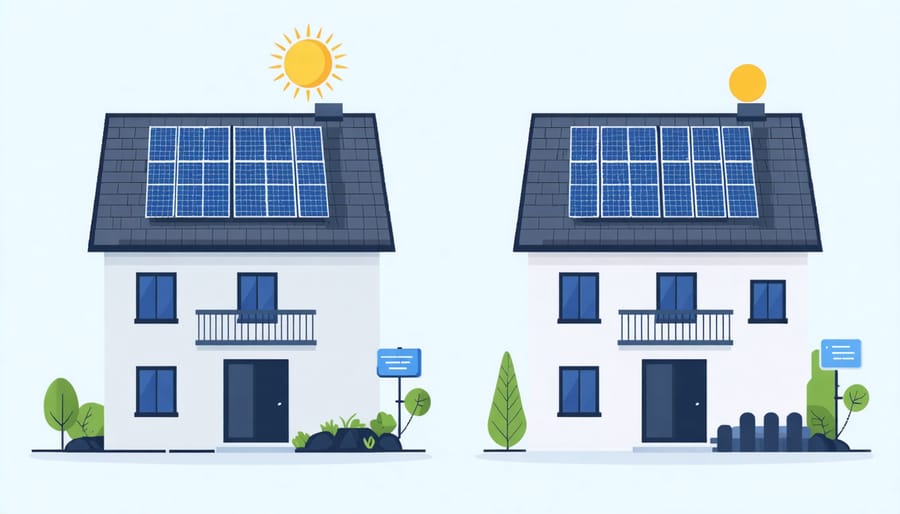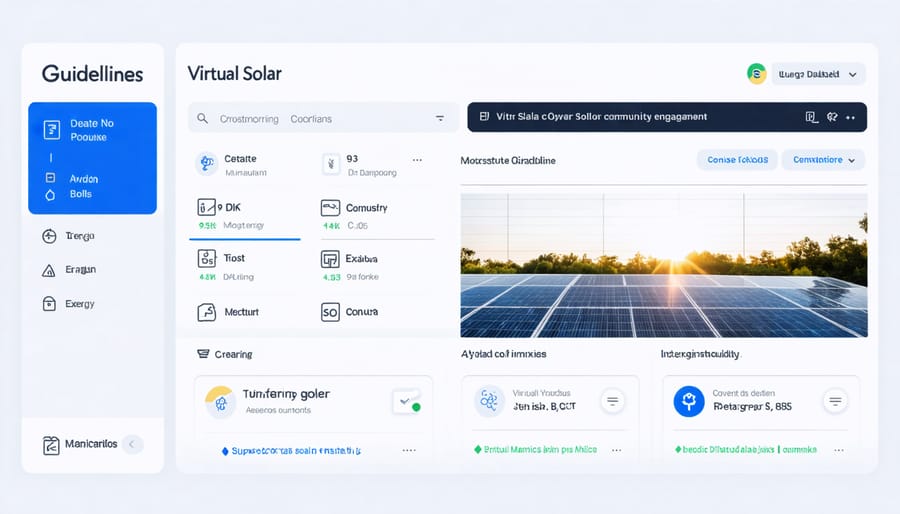As organizations scale their sustainability initiatives, the choice between community solar and rooftop solar installations represents a critical strategic decision that impacts both bottom-line economics and environmental leadership positioning. Recent market analysis shows community solar projects growing at 121% annually, while traditional rooftop installations maintain steady 15% year-over-year growth – highlighting the emerging significance of this choice for business leaders and property managers.
Community solar’s innovative shared ownership model enables multiple stakeholders to benefit from a single large-scale installation, often reducing initial capital requirements by 40-60% compared to individual rooftop systems. Meanwhile, rooftop solar offers unmatched energy independence and direct control over installation, maintenance, and power generation, typically delivering 20-30% reduction in electricity costs through on-site generation.
This evolution in solar deployment models comes at a crucial time when 67% of businesses report sustainable energy adoption as a top priority, yet face complex decisions about implementation methods. Understanding the distinct advantages, financial implications, and community impact of each approach has become essential for organizations seeking to optimize their renewable energy investments while building stronger stakeholder relationships.
Understanding Community Solar Projects

How Community Solar Operations Work
Community solar operations function through centralized solar facilities that serve multiple subscribers. These facilities, typically ground-mounted arrays or large rooftop installations, generate electricity that’s fed directly into the local power grid. The energy production is then monitored and allocated among participating subscribers based on their share size.
Subscribers receive credits on their utility bills proportional to their share of the solar facility’s output. This credit distribution system, often called virtual net metering, allows participants to benefit from solar energy without installing panels on their property. The facility operator manages all maintenance, repairs, and system monitoring, ensuring optimal performance.
The administrative process involves careful tracking of energy production and consumption patterns. Sophisticated software platforms monitor real-time generation data and automatically calculate subscriber credits. Utility companies work directly with solar facility operators to apply these credits to subscribers’ monthly bills, creating a seamless experience for participants.
Most community solar projects operate under long-term agreements, typically 20-25 years, providing stable energy costs and predictable returns for subscribers. Regular performance reports and transparent billing help subscribers track their savings and environmental impact.
Virtual Net Metering Benefits
Virtual net metering enables community solar subscribers to receive energy credits directly on their utility bills based on their share of the solar project’s production. This billing mechanism allows multiple participants to benefit from a single solar installation, even if they don’t own or have access to suitable roof space for solar panels.
Under this arrangement, the utility company tracks the total energy production from the community solar farm and allocates credits to subscribers proportionally. These credits offset participants’ electricity consumption charges, potentially reducing their monthly utility bills by 10-15% on average. The exact savings depend on factors such as subscription size, local utility rates, and project performance.
For business owners and property managers, virtual net metering simplifies the accounting process by automatically applying credits to existing utility accounts. There’s no need for separate meters or complex billing systems. Additionally, subscribers can maintain their credits if they relocate within their utility’s service territory, providing flexibility that traditional rooftop solar installations cannot match.
The system also enables organizations to scale their renewable energy participation without infrastructure modifications or upfront capital investments, making it an attractive option for sustainability initiatives.
Rooftop Solar Systems Explained
Direct Ownership Advantages
Direct ownership of rooftop solar installations offers significant advantages for businesses and property owners seeking complete control over their energy infrastructure. With full ownership, organizations can customize their solar system’s design, capacity, and equipment specifications to precisely match their energy requirements and facility constraints.
This control extends to maintenance schedules, allowing owners to implement preventive maintenance programs that align with their operational needs. Organizations can also directly benefit from available tax incentives, depreciation benefits, and renewable energy credits without sharing these advantages with third parties.
Ownership enables immediate system modifications or upgrades as energy needs change or technology improves. This flexibility is particularly valuable for businesses experiencing growth or evolving energy demands. Additionally, direct ownership typically results in higher property value appreciation, as the solar installation becomes a permanent asset of the building.
Financial returns are often more substantial with direct ownership, as businesses avoid ongoing subscription fees and can fully capitalize on reduced utility costs. The ability to monitor and optimize system performance directly leads to better energy management and increased ROI over the system’s lifetime.
Installation and Maintenance Considerations
Installation requirements differ significantly between community and rooftop solar systems. Rooftop installations require thorough structural assessments to ensure your building can support the array’s weight, along with electrical system evaluations and potential upgrades. Property owners must coordinate permits, inspections, and meet local building codes.
Community solar installations, managed by specialized developers, eliminate these individual property requirements. Subscribers don’t need to worry about installation logistics or structural modifications to their buildings.
Maintenance responsibilities also vary considerably. Rooftop solar owners must regularly clean panels, clear debris, monitor system performance, and address any equipment issues. This typically involves scheduling professional maintenance services 2-4 times annually and responding to unexpected repairs.
In contrast, community solar subscribers benefit from professional maintenance teams that handle all upkeep requirements. The solar facility operator manages panel cleaning, equipment repairs, and system optimization. This reduces operational responsibilities for participants while ensuring optimal system performance through economies of scale in maintenance operations.
Emergency repairs and equipment replacement costs fall to individual owners in rooftop systems but are included in community solar subscription agreements, providing more predictable long-term expenses.

Financial Comparison
Initial Investment Analysis
The initial investment landscape differs significantly between community and rooftop solar installations. Rooftop solar typically requires a substantial upfront investment, ranging from $15,000 to $25,000 for an average commercial installation. This investment covers equipment, installation, permitting, and interconnection costs. However, various solar financing options like leases, power purchase agreements (PPAs), and commercial loans can help manage these costs.
Community solar, conversely, often requires minimal to no upfront investment. Participants typically subscribe to a share of a larger solar installation, paying only for the energy they consume. This model eliminates installation and maintenance costs while providing immediate savings on electricity bills. Businesses can choose subscription terms that align with their budget and energy needs.
For property owners, the ROI timeline varies between the two options. Rooftop installations generally achieve payback within 5-7 years, offering complete ownership and potentially higher long-term returns. Community solar provides immediate cost savings without the responsibility of ownership, making it particularly attractive for businesses with limited capital or those operating in leased facilities.
The choice between these options often depends on factors such as property ownership, available roof space, and financial objectives. Both models offer viable paths to solar adoption, with different initial investment requirements suited to diverse business needs.
Long-term ROI Projections
When analyzing long-term ROI projections, both community solar and rooftop solar installations demonstrate compelling financial returns, though their pathways to profitability differ significantly. Rooftop solar typically shows a payback period of 5-8 years, with ROI ranging from 10-12% annually over a 25-year system lifetime. Initial investments average $15,000-$25,000 for residential installations, with commercial systems scaling proportionally.
Community solar presents a different investment profile, with lower upfront costs and shorter commitment periods. Subscribers generally see immediate savings of 5-15% on electricity bills, with cumulative returns reaching 15-25% over ten years. The absence of installation and maintenance costs significantly reduces financial risk while maintaining steady returns.
A comparative analysis of 50 commercial properties across diverse regions showed that rooftop solar installations achieved complete ROI in 6.2 years on average, while community solar participants realized net positive returns within the first year of subscription. However, long-term value accumulation favored rooftop installations, with total 20-year savings averaging 2.5 times higher than community solar subscriptions.
Property value appreciation adds another dimension to ROI calculations. Buildings with rooftop solar installations typically see a 4-6% increase in property value, providing additional return potential beyond energy savings. While community solar doesn’t directly impact property values, it offers flexibility to transfer or cancel subscriptions, making it an attractive option for businesses with changing energy needs or location requirements.
Building Virtual Communities
Digital Engagement Platforms
Modern digital platforms are revolutionizing how solar energy communities interact and manage their shared resources. These innovative tools enable both community solar and rooftop solar participants to monitor performance, track savings, and engage with fellow solar adopters in real-time.
Mobile applications and web-based dashboards provide users with detailed analytics about their solar production and consumption patterns. These platforms typically feature intuitive interfaces that display energy generation data, environmental impact metrics, and financial savings calculations. Many solutions incorporate gamification in solar energy to increase user engagement and encourage sustainable behaviors through friendly competition and rewards systems.
For community solar projects, these platforms facilitate transparent communication between project managers and subscribers. Features often include automated billing systems, credit allocation tracking, and community forums where members can share experiences and best practices. Some platforms even integrate social media elements, allowing participants to showcase their contributions to renewable energy adoption and inspire others in their network.
Rooftop solar owners benefit from specialized monitoring tools that provide real-time system performance data and maintenance alerts. These platforms often include predictive analytics capabilities that help optimize energy usage and identify potential issues before they impact system efficiency. Many also offer integration with smart home devices, enabling automated energy management and enhanced cost savings.

Knowledge Sharing Networks
Knowledge sharing networks play a vital role in maximizing the benefits of both community and rooftop solar installations. These networks facilitate information exchange, best practices, and customer feedback insights among solar energy users, creating a robust support ecosystem for sustainable energy adoption.
For community solar participants, these networks often take the form of online platforms and regular meetups where members can share experiences, troubleshoot common issues, and discuss optimization strategies. Many successful community solar projects incorporate educational programs that help subscribers understand their energy consumption patterns and maximize their cost savings.
Rooftop solar owners benefit from similar support systems, typically organized through installer networks, homeowner associations, or dedicated solar user groups. These networks provide valuable resources for maintenance tips, performance monitoring, and regulatory updates. Professional organizations often facilitate workshops and webinars focusing on system optimization and emerging technologies.
Both models benefit from digital platforms that track and share performance metrics, enabling participants to benchmark their systems and identify improvement opportunities. Many networks also maintain databases of qualified contractors, equipment suppliers, and maintenance services, ensuring members have access to reliable support when needed.
Educational resources within these networks often include technical documentation, case studies, and financial analysis tools, helping participants make informed decisions about their solar investments and ongoing system management.
Making the Right Choice
Selecting between community solar and rooftop solar requires careful consideration of multiple factors specific to your organization’s needs and circumstances. Begin by evaluating your property’s physical characteristics, including roof condition, available space, and solar exposure. For rooftop installations, structural integrity and orientation are crucial determinants.
Financial considerations should encompass both immediate and long-term perspectives. Analyze initial investment requirements, available incentives, and projected ROI for each option. Community solar typically offers lower upfront costs and eliminates maintenance responsibilities, while rooftop installations provide greater control and potentially higher long-term savings.
Consider your organization’s energy consumption patterns and sustainability goals. Rooftop solar offers direct energy production and visible demonstration of environmental commitment. Community solar provides flexibility in subscription levels and can be particularly advantageous for organizations with multiple locations or limited roof access.
Regulatory environment and utility policies in your area may influence your decision. Some regions offer more favorable incentives for one option over the other. Working with AI-powered solar consultations can help navigate these complexities and identify the most advantageous path forward.
For organizations prioritizing community engagement, both options offer unique benefits. Rooftop installations provide visible leadership in sustainability, while community solar enables broader participation and collaborative environmental impact. The final decision should align with your organization’s strategic objectives, financial capabilities, and operational requirements.
The choice between community solar and rooftop solar installations represents a significant decision that requires careful consideration of multiple factors. Both options offer viable paths toward sustainable energy adoption, with distinct advantages that cater to different organizational needs and circumstances. Property characteristics, financial capabilities, and long-term sustainability goals should guide this decision-making process.
For organizations with suitable roof space and the ability to manage installation and maintenance, rooftop solar provides direct control and potentially higher returns on investment. Conversely, community solar offers an accessible alternative for those facing space limitations or seeking lower upfront costs, while still contributing to renewable energy adoption and sustainability targets.
When evaluating these options, consider conducting a thorough site assessment, analyzing financial projections, and consulting with solar energy experts to determine the most appropriate solution. Remember that both approaches contribute significantly to reducing carbon footprints and advancing sustainable energy adoption. The key is selecting the option that best aligns with your organization’s specific circumstances, goals, and resource capabilities.

